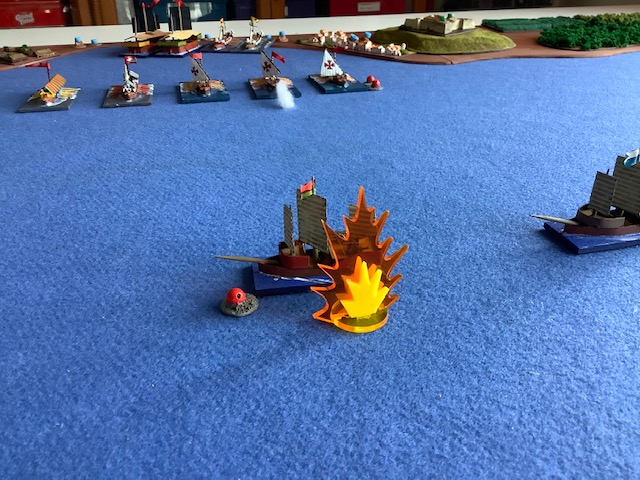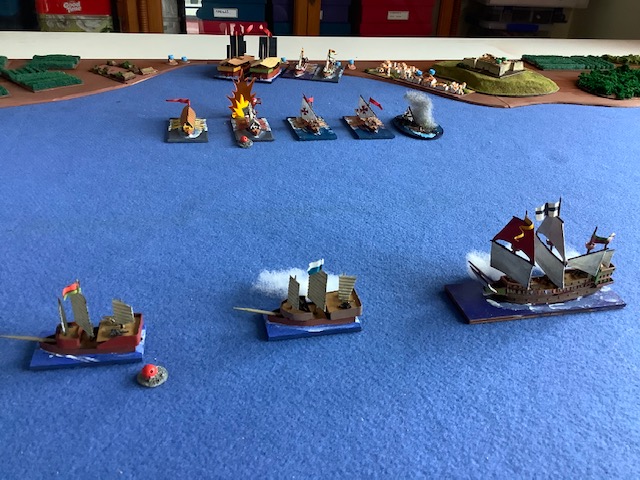Galleys & Galleons - The Siege of Kupang (part 3)
4. The Portuguese relief force arrives
We’ll draw a veil over the responses of the alliance commanders to news that a Portuguese relief squadron was on the offing. Let’s just say it made the Trump White House seem like a well-oiled machine. But somehow, by the time enemy sails were sighted, there were three galleys of the Knights of St Michael of Singapore, and two more of Songkhla (undermanned) ready to meet them, commanded by Gian Andrea Pecorino in the Corona.
The galleys were deployed to protect the bay anchorage where the other non-operational galleys, and the transport junks, were sheltering. Land troops were deployed to prevent the Portuguese from coming ashore and burning them (a favourite tactic).
In accordance with the contingent dice rolls the Portuguese comprised the Galleon Santa Caterina da Goa and the frigates Sao Jorge and Sao Martinho. The commander, you won’t be surprised to learn, was that popinjay Don Marco de Pattaya (self styled Viceroy of the Indies) himself, on the galleon.
The Portuguese approached in line ahead, broad reaching.
It was apparent they had arrived too late to save Kupang. But inflicting a serious defeat on the invaders might open the possibility of retaking the fortress. Don Marco strode purposefully down to the larger of his staterooms and ordered his various armours and plumes to be paraded for inspection. Wearing the right finery would be integral to success.
The Portuguese squadron turns to starboard to close the galleys, then to port again with the intention of passing them at about 1.8L and serving full broadsides using their superior gunnery (Master gunner + Trained gun crew). The next photo shows the squadron in mid evolution. Luckily every ship rolled enough activations to make the necessary manoeuvres (some sail shortening was needed as well as the changes of course). Now, as Turn 4 begins, the leading frigate (Sao Martinho) prepares to open fire.
All this time the galleys have remained stationary. Pecorino needs to play it cautiously. If the Portuguese can incapacitate his squadron the expeditionary force will be marooned. If he attacks, the Portuguese are more than 2M from his line and will be able to blast his ships from close range as they approach. And his two Songkhla galleys (on the L in the above shot) are critically undermanned and not good for anything ambitious. His best tactic could be to suck up the fire from the Portuguese initial sail-by, and attack from their stern quarters as they manoeuvre to come around again close-hauled.
At the start of Turn 4 the Sao Martinho, the leading frigate, opened fire on the galley Cervesa with a full broadside, followed by Sao Jorge with a similar result.
The galley line returned fire, the Corona scoring a single hit on the Sao Martinho.
As Turn 5 clicked over the Portuguese line continued it’s progress, tho it’s shooting was less effective. But by the end of the turn the Cervesa had taken three hits. However return fire from the galley line was ineffective.
Next Turn the Portuguese got their eye in again, damaging the galley Songkhla and sinking the Cervesa. Return fire from the galleys was ineffective.
Gian Andrea Pecorino now has only four seaworthy galleys left, of which two are severely undermanned and no match for a Portuguese ship In a shooting or boarding fight. As commander of the Knights of St Michael contingent he’s conscious that he is responsible for saving what he can from this situation. Soon the accursed enemy line will have passed his galleys and will have to manoeuvre to return, close hauled, to continue the fight. He convenes a hurried Council of War with his staff and they agree: time to cut and run. The Songkhla galleys will have to chose whether to stay and be destroyed, or flee too. The forces on land must shift for themselves.
In Turn 7 this escape plan was literally blown out of the water. A full broadside from the big Portuguese galleon on the Corona, Pecorino’s flagship, lead to a critical hit roll - and a magazine explosion!
The only remaining intact galley, Stella Artois, immediately turned to flee. The next galley, Songkhla, survived rolling on two coloured dice because it’s sole failure resulted in a “hard to port” result - exactly what the doctor ordered! And the last remsining galley, Borobudur, likewise turned to run.
The final broadside of the engagement was fired by the galleon at the retreating galleys, it caused two more hits to the Borobudur, taking it to three hits.
Don Marco’s squadron will have to do a cumbersome turn now, to pursue the fleeing galleys or bombard the transports and other galleys in the bay, with the wind nearly dead foul. So the fleeing galleys will be able to escape, though whether the damaged ones will ever get home across open waters is uncertain.
The popinjay of the Indies has done it again - up to a point. The enemy alliance has been comprehensively demolished by sea, but remains in control of the fortress of Kupang, with adequate land forces to prevent any immediate prospect of the Portuguese retaking it. So we’ll call it a strategic defeat for the Portuguese. But also for the Songkhla / Knights Alliance as it has suffered serious losses and Kupang has turned into a Dead Sea Fruit.
Next time I think I’ll have to extend it into a ladder campaign format.. Typically both sides were aware, sometimes years ahead, who would strike the next blow and where it would fall. Guilmartin comments that there was an underlying logic or pattern to galley warfare in the period, readily apparent to contemporaries (and discussed in their correspondence) thoUGH not so much to us.
Cheers from Mark
The Siege of Kupang







Comments
Post a Comment